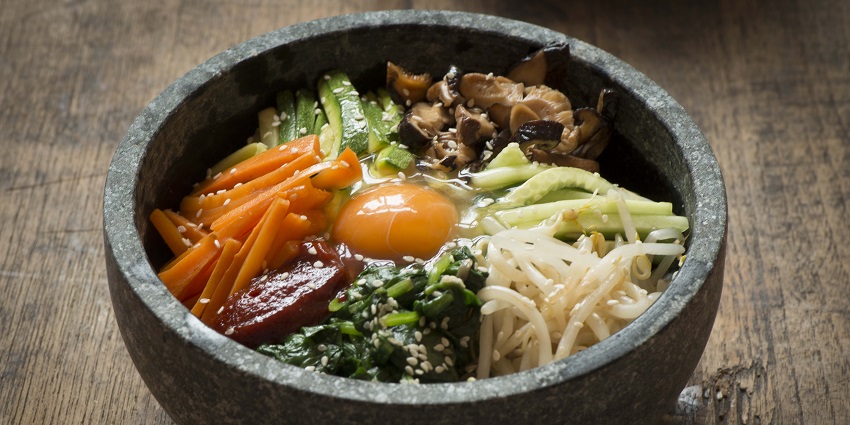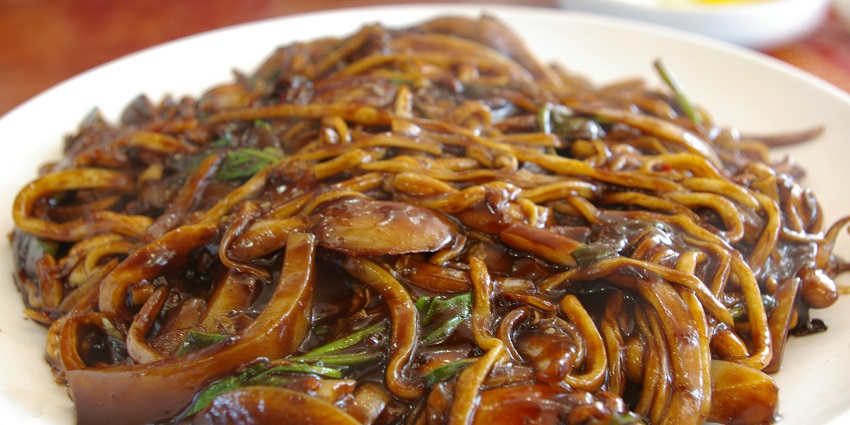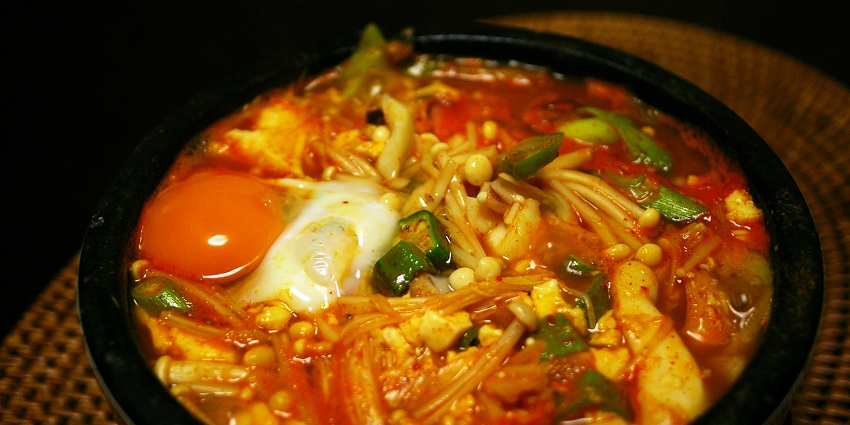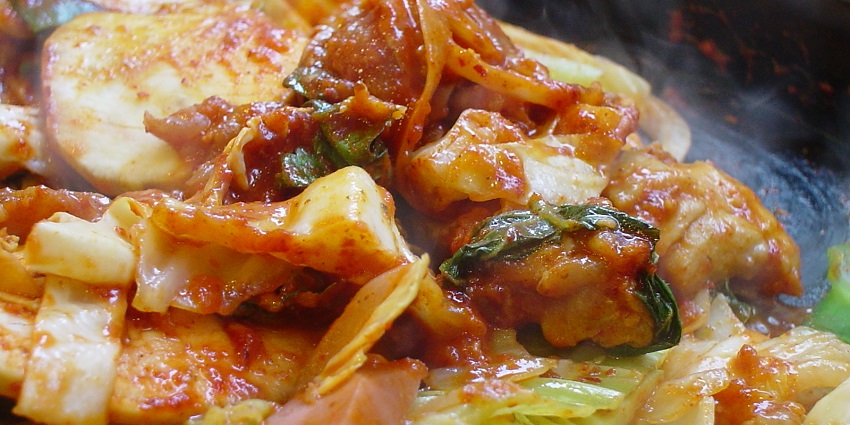South Korea is a country where food is more than just eating—it is a big part of culture and daily life. Food in South Korea is flavourful and fresh, and often includes rice, vegetables, and meat. Many dishes are cooked with garlic, sesame oil, and spicy sauces. Each region has special dishes, like bibimbap from Jeonju and seafood pancakes from Busan. Meals are often shared with family and friends. Korean food is loved for its balance of flavours and is enjoyed worldwide, with many dishes, like Kimchi, becoming internationally famous.
10 Best Foods In South Korea
Here’s a selection of South Korea’s most delicious and iconic dishes, showcasing the bold flavours, unique textures, and rich culinary traditions that make Korean cuisine stand out:
1. Kimchi

Photo: CC0 Public Domain / pxhere / Image For Representation Only
Kimchi is made by fermenting cabbage or radish with garlic, chilli powder, ginger, and fish sauce. This dish is known for its tangy, spicy, and umami-rich taste, which deepens over time. It is eaten as a side dish with almost every meal and is also used in soups, stews, and fried rice. The fermentation process enhances its probiotic benefits, making it great for digestion. With hundreds of regional variations, Kimchi remains a core part of Korean cuisine.
Average Cost: ₹180 – 450
Locations: Seoul, Jeonju, Busan
2. Bibimbap

Photo: Sous Chef / Wikimedia Commons / Image For Representation Only
Bibimbap features a mix of warm rice, sautéed vegetables, marinated meat, and a fried egg. It is served with gochujang (spicy red pepper paste), which adds depth to the dish. Traditionally, bibimbap is mixed before eating, ensuring every bite has different textures and flavours. Dolsot bibimbap is a popular variation in a hot stone bowl that crisps the rice at the bottom. This hearty and nutritious dish is perfect for a balanced meal.
Average Cost: ₹540 – 1,350
Locations: Jeonju, Seoul, Gwangju
3. Tteokbokki

Photo: CC0 Public Domain / pxhere / Image For Representation Only
Tteokbokk is made with chewy rice cakes stir-fried in a spicy, slightly sweet gochujang-based sauce. This popular street food is often served with fish cakes, boiled eggs, and scallions. Some modern variations include cheese or black bean sauce. The soft texture of the rice cakes and the bold, spicy flavour make it a favourite snack. It is commonly enjoyed with a side of odeng (fish cake skewers) and a cup of warm broth during colder months.
Average Cost: ₹360 – 900
Locations: Seoul, Busan, Daegu
4. Jjajangmyeon

Photo: 아침꿀물 / Wikimedia Commons / Image For Representation Only
Jjajangmyeon is one of the best street foods in South Korea, featuring thick wheat noodles topped with a rich black bean sauce made from chunjang, pork, and vegetables. Originally influenced by Chinese cuisine, it has become a staple in Korean dining. The sauce has a deep, savoury flavour with a slight sweetness, making it a comforting and filling dish. It is often eaten on “Black Day,” a Korean tradition for singles. Served with pickled radish and raw onions, this dish is a favourite for casual dining.
Average Cost: ₹540 – 1,350
Locations: Incheon, Seoul, Busan
5. Japchae

Photo: CC0 Public Domain / pxhere / Image For Representation Only
Japchae is made from sweet potato glass noodles stir-fried with thinly sliced beef, mushrooms, and colourful vegetables. It has a savoury-sweet flavour, enhanced with soy sauce and sesame oil. Originally a royal dish, japchae is now served at celebrations and gatherings. The chewy texture of the noodles, combined with the crunch of vegetables, makes it a satisfying dish. It is often enjoyed as a side dish or a main meal with rice.
Average Cost: ₹720 – 1,620
Locations: Seoul, Incheon, Busan
6. Gimbap

Photo: changupn / Wikimedia Commons
Gimbap resembles sushi with different fillings and flavours. The seaweed-wrapped rice rolls contain fish cakes, pickled radishes, eggs, and vegetables. Some versions include tuna, beef, or cheese. It is a common snack for picnics, school lunches, and street food stalls. The slightly sweet, sesame-flavoured rice and fresh fillings make it a satisfying and portable meal. Unlike sushi, gimbap does not use raw fish, making it more accessible.
Average Cost: ₹360 – 900
Locations: Seoul, Jeonju, Busan
7. Mandu-guk

Photo: Trainholic / Wikimedia Commons / Image For Representation Only
Mandu-guk is enjoyed especially during the Lunar New Year. This comforting soup features mandu (Korean dumplings) filled with pork, beef, or vegetables, served in a light, savoury broth made with beef or anchovy stock. Thinly sliced rice cakes (tteok) are sometimes added for extra texture. The dumplings absorb the rich flavours of the broth, creating a warm and satisfying dish. It is traditionally garnished with spring onions, egg strips, and seaweed. Mandu-guk is a popular winter dish, providing both warmth and nourishment.
Average Cost: ₹720 – 1,620
Locations: Seoul, Incheon, Busan
8. Sundubu-jjigae

Photo: by titanium22 / Wikimedia Commons / Image For Representation Only
Sundubu-jjigae is known for its rich, spicy broth, which is made with soft tofu, vegetables, and often seafood or pork. It is served boiling in an earthenware bowl, which helps retain its heat. A raw egg is typically cracked on top just before serving, adding extra richness to the dish. The tofu absorbs the flavours of the spicy gochujang-based broth, creating a warm and comforting meal. It is commonly eaten with a bowl of steamed rice.
Average Cost: ₹540 – 1,350
Locations: Seoul, Busan, Jeonju
9. Dakgalbi

Photo: by shizu k / Wikimedia Commons / Image For Representation Only
Dakgalbi features marinated chicken stir-fried with cabbage, rice cakes, and sweet potatoes in a spicy gochujang-based sauce. It is often cooked on a large hot plate at the table, with customers stirring their portions. Many restaurants offer the option to add cheese for extra richness. After finishing the main dish, diners often mix rice with the remaining sauce to create delicious fried rice. This dish is popular for social gatherings.
Average Cost: ₹900 – 1,800
Locations: Chuncheon, Seoul, Incheon
10. Hotteok

Photo: Korea.net / Wikimedia Commons / Image For Representation Only
Hotteok is enjoyed as a winter snack. These thick pancakes are filled with a sweet mixture of brown sugar, cinnamon, and chopped nuts. When cooked on a griddle, the sugar melts inside, creating a gooey, caramelised centre. The crispy outside and soft interior make it a comforting treat during colder months. Some modern versions include cheese, red bean paste, or savoury fillings. It is commonly found in traditional markets and street stalls.
Average Cost: ₹180 – 540
Locations: Seoul, Busan, Gwangju
Food in South Korea is not just about taste; it is an important part of tradition and daily life. From spicy stews to grilled meats and delicious side dishes, there is always something exciting to try. Many Korean dishes, like Kimchi and bibimbap, are now enjoyed worldwide under different names. Book your trip with TripXL and savour the authentic flavours of South Korea.
Cover Photo: ROMAN ODINTSOV / Pexels / Image For Representation Only


 WhatsApp
WhatsApp
 Twitter
Twitter









